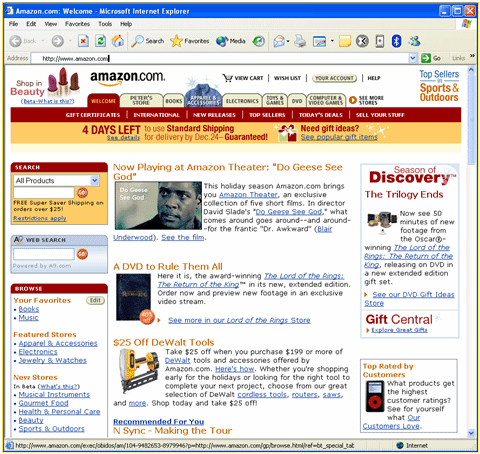Design Elements of Popular Websites

With literally billions of Websites clamoring for your attention on the Internet, it is essential for organizations to recognize that, as in any business, there are important do's and don'ts for Webpage design. As soon as a few basic rules have been satisfied during the initial process, the new Website is likely to receive higher amounts of traffic than their incomprehensible counterparts.
The first and most essential thing that any Internet author must remember is that a Website is a communication tool. As such, its primary purpose should be to inform. Even if it's equipped with bells and whistles that make it look really cool, the Webpage will be useless if it cannot be understood, navigated, or is incapable of receiving any visitor feedback. Clear, concise copy (writing) must be prominently displayed and work in harmony with any audio, video, or graphics that are present, not overpowered by them. After all, if visitors to your site do not comprehend whatever message you're trying to communicate, they are unlikely to return or recommend the Webpage to other users.
* Create something that is useful- I know this may sound like a no-brainer, but it is necessary that your Website not only be an effective communication tool, but a tool that allows visitors to immediately act on the information they have received. For instance, if you're designing a company Website for a new winery, the Website should not only inform consumers about the business history, vineyard, wines, and other products available for sale, but it should also offer a way for visitors to purchase products direct from your website and/or include links to your commercial partners and affiliates.
* Make sure it's readable and looks "nice"- Background colors (or wallpaper) often are most effective when they are monochromatic and light in color. A patterned background should be avoided unless there is a specific reason behind it. Two-tone backgrounds can be used when the designer wants to divide the page. Make sure that your background color and text color contrast so your text is legible. Type fonts should not vary --randomly switching from Arial to Bookman type fonts is not only unattractive, but very distracting.
* Make sure your Webpage is interactive- In short, an interactive Website gives visitors ways to participate. In today's melee of Internet sites, Web users expect to interact meaningfully with websites. When users are satisfied with your site, they'll stay longer, return repeatedly, and post links to the site elsewhere on the Internet. Interactive websites encourage these behaviors, so it's not illogical that the most popular sites are highly interactive and let visitors leave comments, post their own content, etc.
* Write like a journalist, not a novelist- When you design a good Webpage, focus on the content, not your literary style. Effective technical writing doesn't call attention to itself for its style, for that is invisible. Its primary purpose is to teach the user how to do something. Of course, you'd like to impress visitors with great graphics and other media, but it is important to keep in mind that the most popular websites are popular because they simply work. Consider Google, Craigslist, and Amazon.com; often the simpler a site, the better.
* Keep it constant- Update information as often as possible. Make sure that your external links are functioning, and that all your contact information is still applicable. If visitors find that you have not taken the trouble to do this, they will question your interest in obtaining their support. After all, if you allow your Website to languish, how can they trust you with their money or loyalty? There is nothing more aggravating than looking for information on a site that hasn't been updated since 2003.
* Learn about Google - If you want your Website to rank highly in the pages of he Google search results, you must understand how this and other search engines work. I suggest you spend a few moments reading the Google official guidelines (http://www.feedthebot.com/google-guidelines.html) and double check that your site follows all the normal optimization rules. Make sure you know which search terms are the most popular, and use that information to create page titles that feature these terms, and are consequently likely to receive more traffic.
What NOT to Do
According to Vincent Flanders' excellent site, "Webpages that Suck," these are the cardinal sins one can commit while designing a Webpage.
- Thinking that people care about the Internet author- In reality, most people visit a site to solve one or more of these four problems: They want/need information; they want/need to make a purchase / donation; they want/need to be entertained; they want/need to be part of a community. In short, it is never about you and what you want, so make sure your site is capable of satisfying the users' needs.
- Using design elements that get in the way of your visitors- All those annoying bells and whistles I mentioned earlier come into play here. If users have a specific goal, like purchasing a bottle of wine, they do not need to be bombarded by pop-up videos that get in the way of their transaction.
- Forgetting the purpose of text- Text is Text. Don't use graphics or Flash for text. Why? It increases the size of the page and therefore will take longer to load; it isn't search engine friendly, and the graphics are often poor quality.
- Too much material on one page- Yes, it's called a Webpage, but that doesn't mean you have to cram all your material on one page. A polite term for this phenomenon is "text-heavy" or "graphic-heavy." However, what it is really is a headache-inducing eyesore. There is white space on any page, please don't be afraid to use it.
- Failing to meet user expectations- People have expectations about Websites and they don't like surprises. Surprise content is just like jumping out of the bushes at someone; disorienting, confusing, and annoying. In fact, surprises are likely to make visitors want to leave and find a site that's less confusing. For instance, "if you're a dentist, your visitors expect your Website to look like it belongs to a dentist - not to someone who is going to the opera."









